Nitrite can cause significant damage to aquatic inhabitants or even kill them.

So how do you protect them if an imbalance occurs?
Why is it that with goldfish nitrite levels can spike more often?
How to reduce said levels on time, without suffering fish losses?
Essentially, you should change some of the water to offset potential damage and then introduce beneficial bacteria in some form to help convert the Nitrite into Nitrate.
But is there also a silver bullet nitrite remover that can take care of the mess?
Let’s dive right in.
- Organic matter degrades to ammonia (NH3).
- Bacteria convert that ammonia to nitrites (NO2-).
- Other bacteria transform the nitrites in nitrates (NO3-).
With that out of the way, we can answer the important questions.
How to promptly lower the nitrite levels in your freshwater aquarium?
Nitrites are the second most toxic byproduct in the nitrogen cycle of an aquarium.
They can be lethal to most freshwater fish if not handled on time. To promptly lower the high nitrite levels in your freshwater aquarium follow these exact steps:
1. Change 30% of the water.
With this initial step, you aim to replace part of the nitrite-rich water and dilute the harmful compound in the tank.
By physically diluting the concentration you will ease the negative effects on your livestock.
I recommend splitting the 30% into two partial water changes of 15% and performing them 1 to 2 hours apart. This way you’ll make sure that the drastic shift in parameters that comes after a larger water change won’t finish off your fish.
Fish can adapt to gradual changes in their environment, including an increase in nitrites.
However, by performing a large water change you significantly alter the water chemistry in a short matter of time.
This can send you fish into an osmotic shock, which is the last thing your fishpals need.
Author’s note: Water changes can also help with reducing high Ammonia levels in your fish tank.
2. Add nitrifying bacteria
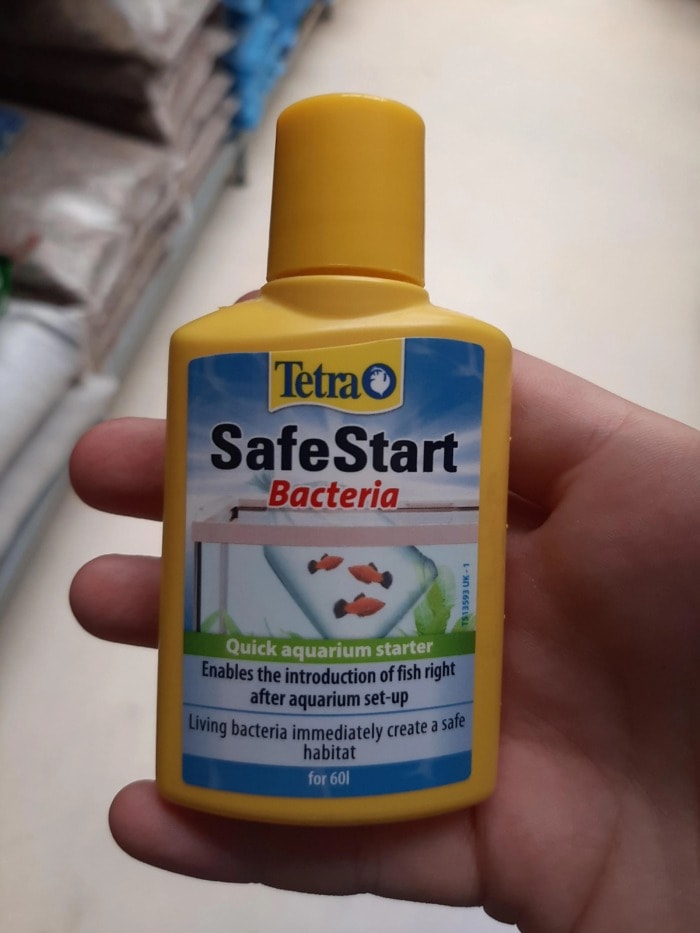
by flexed_guitar
Since high nitrite levels are signaling an incomplete nitrogen cycle, adding some good bacteria to the system should be your second course of action.
One of the most efficient ways to quickly add beneficial bacteria to your tank is by using bottled bacteria. There are many bottled bacteria products on the market.
Most of them are complete garbage, however, the reason being the use of cheap-grown land-based nitrifying bacteria.
These land-based organisms will essentially outcompete the not-well-established aquatic bacteria and then die out in underwater conditions.
And then you’ll be left with another spike in nitrites and no one to handle that. Luckily, after conducting my own experiments, I found four sound products that do actually work as marketed.
I also did a detailed comparison between two of them here, and namely Tetra SafeStart and API Quick Start. In the link, I also include the correct ways to use them.
For the purpose of controlling nitrites, I strongly recommend using Tetra’s SafeStart Plus.
From what I’ve found, it arguably has more nitrite-converting bacteria than API’s Quick Start product.
Look it up online (you can check it out here, on Amazon) or rush to your local fish store and buy it, as soon as you have the chance. If you do end up in the fish store make sure to get a bottle that’s as manufactured as recently as possible.
Amazon supplies are usually fresh, but in some cases, you may get lucky in your LFS as well.
Dose accordingly, but in my experience, you should pour the whole bottle in anything larger than 30 gallons.
It is beneficial bacteria and it won’t do harm to your fish.
I’m sure you already figured that but here it is anyway- supply yourself with the bacteria first, so you can add it immediately after the initial water change from step number one.
Avoid changing the water for the next couple of days to let the bacteria establish themselves.
The only time you should change water is if there’s a following inexplicable spike in Nitrite.
Though Seachem is a reputable brand in the hobby, they refuse to name the bacteria used in their product.
This is what stopped me from even bothering to test it, and therefore I can’t really recommend using it.
3. Set up a filter if you haven’t already

by GandolfBesh
The media in our aquarium filters is where most beneficial bacteria live.
By setting up a filter you will do two things – improve the oxygen levels in the water and provide a living place for the new bacteria.
The first will help your present fish to cope with the lower oxygen levels in their blood, caused by the potential nitrite intoxication.
If you happen to have another established tank around you’re in luck.
Use SOME of its biological filter media in your nitrite-rich tank.
There you’ll have an already thriving bacterial colony that could immensely speed up the cycling process in the problematic fish tank.
Don’t borrow too much.
I’d recommend no more than 30% of the total biological media.
Aquarium filters are an invaluable piece of equipment when it comes to maintaining stable water parameters.
Even though you can harbor live fish without one, doing so is extremely difficult and requires advanced fish keeping knowledge.
So do your fish and yourself a favor, and don’t skimp on the aquarium filter.
Smaller aquariums can do with a simple HOB or sponge filter which barely cost a thing.
Note: For larger aquariums, perhaps, a smart decision would be to set a canister filter, as they have way more space for filter media and provide a very decent water turnover.
4. Add substrate from an established aquarium
The logic behind this is pretty much the same as in the previous step.
Bacteria also inhabit the substrate of your aquarium.
By adding some substrate from an established aquarium to your affected one you improve the bacteria’s numbers.
I’m emphasizing some, as you don’t want to inflict the same pain to your other fish.
A few scoops should be able to aid you in the battle against nitrite.
5. Hook up your filter to an already established tank
If by chance, you have another up-and-running aquarium, you can connect your filter to it and let it run for a week.
This will let the bacteria from your old aquarium colonize the media in your new filter.
Afterwards, all you need to do is install the filter into the new tank and wait until the nitrite levels drop.
Needless to say, you shouldn’t remove the filter from your already established aquarium if you’re going to attempt this. Doing so will remove all of the beneficial bacteria from it and ruin the nitrogen cycle.
Another thing I should point out is that this method will only work if you’re setting up a new aquarium.
If you’re dealing with a nitrite spike in an established aquarium, you should skip it.
How to (and should you) reduce nitrites in a saltwater fish tank?
In saltwater fish species nitrite is not toxic at all, or at least not notably toxic.
In freshwater aquariums, nitrite can be absurdly toxic to the fauna.
This is because it blocks oxygen uptake by binding to hemoglobin and transforming it into methaemoglobin.
Chlorides, however, prevent this by inhibiting the uptake of nitrite from the water.
And since the chlorides in freshwater aren’t enough, there’s nothing to stop nitrite from entering a fish’s bloodstream.
In some cases of elevated nitrite, this leads to chloride depletion in a fish’s body.
After nitrites enter a fish’s system, the balance of a number of biological mechanisms gets disturbed.
However, when salt is present in the water the chloride levels skyrocket.
That’s because the salts in saltwater contain chloride as is seen from their chemical formula, which is NaCl (Sodium + Chloride).
At chloride levels of 1.94% (or ~19,350 ppm) the nitrites can not outcompete them and poison a fish.
In some cases, a freshwater fish specimen will be a THOUSAND times more sensitive to nitrite than a saltwater fish.
The sensitive freshwater species are usually the ones that have adapted to living in soft water.
See, I’m not a chemist, but I do read a lot, to ensure the safety of my fish. I learned all of that from this guy, who’s a doctor and knows what he’s talking about.
If for some godawful reason you managed to raise them that much you should introduce nitrifying bacteria to the tank:
BIO-Spira and API Quick Start are very useful here.
Tetra SafeStart Plus is designed for freshwater aquariums by definition and won’t be of use for a marine tank.
Anyway, either BIO-Spira or API’s Quick Start will speed up the nitrogen cycling.
Still, if the nitrites are this high, there’s probably something large that is rotting or you just threw out too much filter media or substrate and decor.
Signs of nitrite poisoning going on in the aquarium?
Sometimes you can spot the symptoms of nitrite poisoning without a test kit.
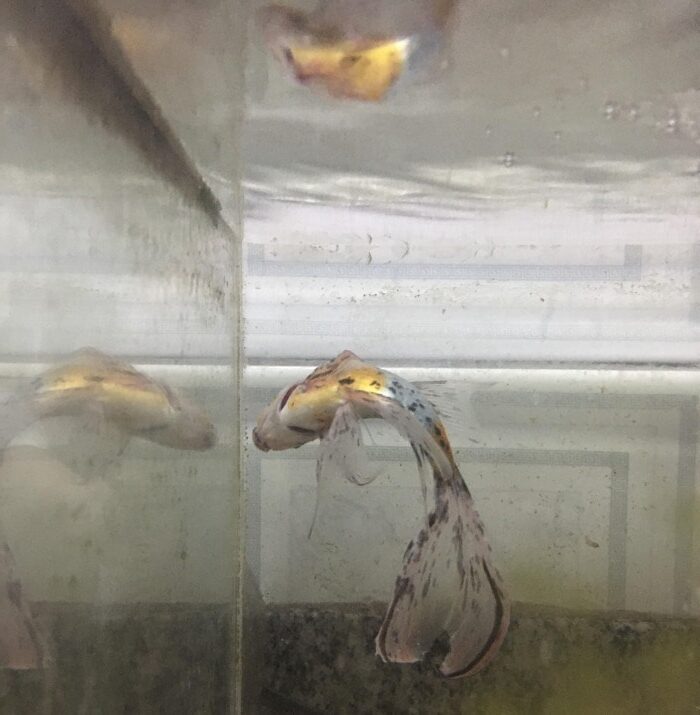
by Trickshroom
Affected fish can show clear symptoms identifying the presence of nitrites.
The signs in fish behavior that signal high aquarium nitrites are the following:
- darkened coloration of the gills;
- lethargic fish that are otherwise active;
- the death of an otherwise healthy fish;
- fish are gasping, with fast movements of the gills;
- constant striving to stay near the water surface.
How to protect your freshwater fish from nitrite intoxication?
The owners of freshwater aquariums should be concerned with their fishes’ health during elevated nitrite levels.
To protect your freshwater fish from nitrite poisoning you should:
- Relocate the fish to an established tank.
This is quite obvious, but some fishkeepers may underestimate the toxicity of nitrite.
Relocating your pet fish is your best bet to ensure their safety and prevent mortalities.
However, I’m assuming that most of you that read this don’t really have an established tank laying around.
Either this or it is full of large predatory fish that won’t really get along with the newcomers. In that case…
- Add rock salt to the water. By adding rock salt to the aquarium you enhance the present levels of chloride.
The elevated chloride will prevent the nitrites from entering your fishes’ body through the gills.
This will make them significantly more tolerant of the toxic compound.
Add 1 teaspoon of non-iodized salt per 10 gallons of water.
However, do your research on your fish before that. Most all scaleless fish (corydoras, loaches, some other catfish), tetra species, most invertebrates, and aquatic plants are very salt-sensitive.
You can use Aquarium-grade salt as well if you have that around.
I do not recommend buying it for the sole purpose of treating nitrite poisoning as it is just overpriced regular rock salt.
Kosher salt, however, is a sound choice.
- Add an air-stone.
After the nitrites enter your fish’s bloodstream they bind to the hemoglobin, oxidizing it to methemoglobin.
The latter does not carry oxygen, which can result in suffocating fish.
This is often called Brown Blood disease.
By adding an air-stone to your aquarium you aim at providing more oxygen to support the already O2-deprived fish.
Prime is a binder. It binds to the nitrites, converting them to other harmless molecules, and the process is labeled as “detoxifying”.
So far, so good, right?
Well, not exactly.
If the bacteria fail to transform all the detoxified nitrites while the effect of Prime lasts they may become overwhelmed when the binder’s effect expires in 24 hours or so.
Another thing to consider is that if you’re using tap water for your freshwater aquarium it will most likely be disinfected through Chloramine instead of Chlorine by your water facility. Chloramine is actually chlorine + ammonia. Seachem Prime removes the chlorine and detoxifies the ammonia.
But that’s actually extra ammonia released in the aquarium by the chemical bond of the two after Prime’s effect expires.
And that’s extra amount converted to nitrite after…
After 48 hours of a nitrite-free aquarium, you will be at your starting point.
This puts many inexperienced fishkeepers in the situation where they continuously use Prime ($$$), claiming it helps the nitrogen cycle.
This is simply wrong and a waste of money.
It is the tank’s bacteria that should be able to handle all the ammonia and nitrite and not external supplements.
High nitrite readings, but 0 ammonia?
The explanation behind this is very simple:
Whenever your aquarium has high levels of nitrites but no present ammonia, it means that it is halfway through its nitrogen cycle. Essentially, the ammonia-converting bacteria have established themselves, while the nitrite-oxidizing colonies are still insufficient in numbers.
If your tank is brand new – this is not the time to add fish, unless you introduce beneficial bacteria in some way. In fact, this is a common vicious cycle where an aquarist would keep seeing their fish die one after the other in their new tank and have no idea why.
Under normal circumstances, the nitrites should get converted to nitrates in 2 to 6 weeks. However, if the water temperature is below 70°F, it will take longer than that. Conversely, if your tank has been established for a while and this happens – something hindered its nitrogen cycle by releasing too many organics into the water.
Acceptable level of nitrites in an aquarium?
It is “acceptable” that we’re discussing here, so depending on your setup and fish species the answer can vary.
However, there’s a universally safe nitrite reading for any aquarium out there:
Generally, the safe level of nitrites in an aquarium is considered to be between 0 and 0.2 ppm (ml/g).
Bear in mind that some species of fish are more nitrite-tolerant than others.
What causes the progressive intoxication is the rapid ingestion of the poison (actually aiming for chlorides) through the gills.
Some fish species do not take up chloride from their gills, which makes them more tolerant to a nitrite spike.
On the other hand, some species of catfish, the fathead minnow, the roach, and the tench fish may be able to withstand a reading of more than 4 ppm.
For saltwater fish, the lower barrier will be as much as 30 ppm of nitrite.
This is quite a lot and, honestly, very unlikely scenario in a home aquarium.
The honorable mention goes to the common eel, which can live comfortably for as much as 4 days in water that has over 1600 ppm of nitrites.
Impressive stuff.
How you got high nitrites in the first place?

Obviously, something lies behind all of this. Well, let me guess.
The significant spike in nitrite levels in the aquarium appeared after:
- You recently added too many fish at once;
- You recently started the aquarium (less than a month and a half ago);
- You did a full clean of the filters and substrate or changed them;
- You have a heavily planted tank but forgot to prune and remove dead leaves lately;
- One of your fish has recently died but you did not immediately remove its body;
- You feed your fish more than twice a day;
- You treated the water with an antibiotic without removing the biological filter first;
- You put ice in the water in an attempt to cool it on a hot summer day;
- You didn’t dechlorinate before a water change;
- You have an overall small fish tank (under 10 gallons).
What all of these have in common is the imbalance between the levels of produced nitrites and the numbers of beneficial bacteria that convert them.
That’s because beneficial bacteria take time to establish themselves whereas any aquarist can almost instantly increase the things that produce nitrite in a tank.
When a complete nitrogen cycle is established in an aquarium the nitrites will be converted into nitrates as soon as they appear.
Adding more than 3 small fish at once can be the difference between overwhelmed bacteria and a healthy 20-gallon tank.
Goldfish are even messier, as are most freshwater eels and other larger carnivorous fish. It is why the “1 inch of fish’s body per 1 gallon of water” rule in aquarium keeping is and always has been utterly wrong.
I mean, fish stores have to make the most of any situation and budget, right?
Another way fishkeepers get rid of their beneficial bacteria by accident is cleaning the tank too much or changing decor and too much of the old filter media.
The biological filter media should only be cleaned when really dirty, and it should be rinsed in dechlorinated aquarium water and not untreated tap water.
Chlorine (or respectively Chloramine) in tap water is harmful to bad AND good bacteria.
And so are antibiotics.
Rotting organic matter can also cause a nitrite spike as it elevates ammonia.
And that includes anything from a dead fish that went unnoticed to copious amounts of waste, food leftovers and even dead plant matter.
Lastly, sudden temperature changes can stress and eventually kill your beneficial bacteria.
Temperature changes in any aquarium should be implemented gradually.
So how to prevent nitrites building up in your aquarium?
The only sure way to stop nitrites from rising is to maintain a stable nitrogen cycle.
This is achieved by ensuring the well-being of your beneficial bacteria.
Overwhelming it with work will inevitably cause an unwanted imbalance in nitrites, nitrates, and even ammonia.
To prevent excessive levels of nitrite in your aquarium, follow these rules:
- Feed your fish once a day.
Offering a meal once a day is a secure way to avoid overfeeding and leaving spoiling leftovers at the bottom of the tank.
You can eliminate overfeeding by getting an automatic feeder.
My heart lies with Eheim’s one (click the link to view it on Amazon.com).
It’s pretty reliable – just set it and forget it.
You also get the added benefit of feeding your fish while you’re out of town.
- Dose food accordingly.
You should not starve your fish, but giving them too much food will result in water pollution.
- Get a bottom-feeder.
Bottom feeders, such as rubber lipped plecos (really cheap, by the way) will scavenge the substrate for leftovers, cleaning them for you. Don’t fool yourself – the bottom-feeding fish itself will also produce waste in the process but it will save you some worries about cleaning food from the substrate.
- Don’t clean all of your aquarium filters at once.
Don’t clean the gravel too often as well, as these places harbor the nitrifying bacteria.
In fact, your substrate holds nearly 20% of all the nitrifying bacteria in your aquarium, so cleaning it all at once might disrupt the nitrogen cycle.
- Rinse your filter media with used aquarium water and not tap water.
Chlorine in tap water is lethal to the good bacteria in a fish tank (click the link to learn how to naturally dechlorinate your water if you want that).
- Do not overstock your aquarium in short periods of time.
Adding too many fish at once will overload your tank with organic waste.
You will lose fish, money and your nitrogen cycle (time) in the process.
- Perform 25-30% water changes on a weekly or bi-weekly basis.
This helps to dilute the contamination in the water, easing the work of the bacteria.
- Set up sufficient aeration.
This will help the fish to get sufficient oxygen from the water, lowering the chance of nitrite poisoning.
Using a powerhead or an airstone is a great way to increase the amount of available oxygen in the water.
- Increase the number of plants in the aquarium.
Plants prefer to feed on ammonia over nitrites.
However, if your ammonia-converting bacteria is in check and you lack the nitrite-converting one, plants will significantly reduce the damage by absorbing the excessive amounts.
Wisteria, Water sprite, duckweed and other floating aquatic plants can do that exceptionally well. That’s because they all grow very fast, sucking up a lot of Nitrogen-based nutrients from the water in the process.
- Remove rotting flesh or food leftovers whenever you spot them.
Often, degrading organic matter is what will cause a spike in nitrites.
- Reduce the incoming UV light, when the tank is cycling.
Beneficial bacteria are sensitive to blue and UV light, so during cycling reduce that to a minimum. Too much incoming sunlight from a nearby window can slow down the cycling process though not significantly.
My Final Thoughts
High nitrites in the aquarium can be considered an emergency if you have live fish in it.
Still, diagnosing whether you’re at the phase of cycling your fish tank or you broke its functioning cycle by accident is crucial.
Finding the reason behind the suspiciously high levels is your final goal.
This way you can properly approach the issue and resolve it, without suffering losses.
Ask in the comments if you need more answers.

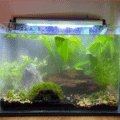
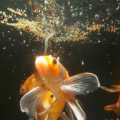


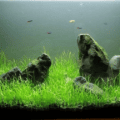

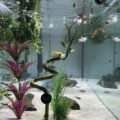
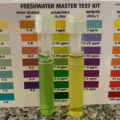
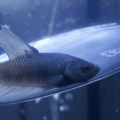
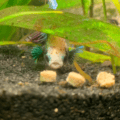
20 gallon fresh water tank ,, added 18 fishes..over cleaned it..
Healthy looking Fishes started to die one by one at a gap of 4-5 days.. First stopped feeding then fast breathing and ulimately death. Tested water and found high nitrite level rest all parameters were stable..Now have 13 fishes..Hope they will survive..
Hi,
Add some salt (NaCl) in there to prevent the nitrite poisoning, man.
That’s unless you have scaleless fish (as I mention in the article above).
Make sure the salt is non-iodized!
Good luck! The sooner you do it the better.
I have a 60gal saltwater aquarium and I have no ammonia or nitrate but 5.0ppm of nitrite I tried using seachem stability but with no results of any less nitrite
How many weeks has tank been cycling?
Did you use fish or fishless cycle!
dry rock/ dry sand or live rock?
dry rock and dry sand takes longer cycling even with bacteria and ammonia I’m in 7 weeks nitrite spike same 3 weeks
I need so much help! Im a brand new goldfish, guppy, ahd pleco owner. My tank is 55gal and I just cannot wver seem to get the water parameters right!
Hi Vanessa,
More info on how long the tank has been around, when did you ad the fish, fish sizes and numbers, what you’ve done and what’s wrong with the readings would be really helpful here.
Hi. My nitrite levels are 1.0 what should I do.
wait, add more bacteria media, make sure skimmer is on and lights turned off to stop algae issues. depends how many weeks in to cycle. you could do a 20% water change but would just wait.
I made the newbie mistake of not completing my cycle and after the lost of my two clownfish I learned my lesson. I removed their bodies right away and change 50% of the water (due to a strong smell, event though they were there for not more than 10min). I added more bacteria to replaced the amount I took with the water change. Now it’s been 6 weeks since that day, I tested and my ammonia disappears in 24hrs but my nitrate and nitrite are still extremely high (I’ve been adding nitrifying bacteria for the past two weeks and still the same). I was told not to add water(refill my nano tank water level) until the cycle is finished. I have lost like 1.3gl in evaporation. Could this be my nitrate/nitrite issue? Should I add more water or just wait?
Hi Mio,
Now after 2 weeks you can top the water off, for sure. You could also do a water change now, most of the bacteria should be established on surfaces. IF you’re 100% sure nothing is rotting inside (which I’m assuming you are) you should probably wait it out. With the bottled bacteria you should be moving towards a fully cycled tank.
By the way, not that it’s of importance at the moment but what caused such violent imbalance in your tank’s cycle is probably its small size. Adding water should’ve been fine from start, water changes were the tricky part. Less water = faster contamination.
Definitely top it off – you’ll not be removing anything from the water. Monitor your readings and if needed do a water change in a couple of days. Luckily nitrites are not as harmful in saltwater tanks!
Makes sense?
Hope this helps!
you need RO water to top up otherwise salinty will go out of wack also after first 2 weeks make sure skimmer is running during cycle stage. I’m running my tank in 7th week saltwater tank started with dry rock and dry sand. I started cycle off with dr timms nitrifing bacteria * one and only in bottle * then added drops of ammonia chloride. ammonia went off chart dropped in 9 days to zero not nitrite went off chart dropped to 1.0ppm and nitrates appeared off chart. I stuck on lower nititres 1.0ppm and nitrates 20ppm light orange, I did add more nitrifing bacteria and did 3 water changes after 4 weeks every week 20%. now added a hermet crab feeding lightly to him every 3 days. skimmer now pulling organic matter out. i think 1 more week, and should have nitrites at 0 and some nitrates in there which I will do a 50% water change and add fish.Join the discussion…
I had a 24 hour power outage. My 110 gallon reef tank was oxygenated during the outage. No flow, no heat. Temp dropped 10 degrees F. Ammonia & Nitrite spike – lost 4 fish, one deresa clam, one rock flower anemone. Did 25% water change, followed several days later by 25% water change. Used de*nitrate and zeolite. Removed some nitrite loving Xenia (bad timing-big mistake). I’m staying at 0 ammonia, 10ppm nitrates (great). However, three weeks later and I still can’t get nitrites to zero. I’ve been using Dr Tim’s nitrifying bacteria for reef tanks and seachem stability. Nitrites remain at .1 to .2 using Red Sea test kit. I don’t think more water changes will help and may hinder the growth of good bacteria. Any suggestions?
Hi, Lia,
If nitrites remain stable, perhaps there’s something you haven’t discovered that also died and is now rotting inside the tank?
3 weeks is a lot of time, considering you are constantly adding beneficial bacteria. Perhaps, change the brand? Have you tried Bio Spira? Many reefers I know seem to swear by it.
Still, my best suggestion is that you thoroughly inspect the tank for rotting matter, because it has taken too long and the readings should’ve stabilized by now…
Hope this helps.
Thanks. I have inspected the tank. I’ve cleaned the sump, rear circ chamber, gate valves, main and circuit pump, changed charcoal/gfo in my reactor, cleaned my algae scrubber, deep cleaned the skimmer. Strange, my sps and lps corals are thriving in a .1 Nitrite environment. I do have a Tonga shelf rock that all my aquascape is sitting on. If something burrowed under there and died, it can’t be more than snails? To get under it, I would have to strip down my tank completely. Maybe my testing solution (Red Sea) is contaminated? I think I’ll get another brand and try that…
Hi Lia,
I don’t think the test strip is the problem. IMO tearing down the tank should be your last resort, yeah. However, a couple of snails can be enough of a contaminant on their own…
Again, 0.1 ppm of nitrite is NOT lethal in a marine tank (in fact, not even stressful for marine life). Consider this before deciding on what to do next. If you haven’t got losses in the past couple of days, maybe it’s better to just wait it out. The nitrifying bacteria will establish itself with time.
Zero this morning!!! It took a month! Thanks for the help.
Ha, told you!
Glad my efforts were of help to someone!
Happy reefkeeping, friend!
This helps me u/s over-cleaning issues I’ve caused. I’ve learned that blood parrot, ram, and angelfish cichlids, and plecos, must be pretty hardy because they’ve survived crazy high nitrite & ph so far (although 2 of my blood parrots have black foreheads now). I’ve lost my loaches which breaks my heart. I went crazy cleaning because I was trying to get rid of ick (sold to me on my clown loach). So if I ever try loaches again, and they get ick, how should I treat it? …and also, if you don’t mind 2 questions, how do loaches and cichlids live together when their ph needs are different?
Thanks again!
I had a power outage for over 24 hours. I was able to pump oxygen into my 110 gallon mixed reef tank. Lost three fish and one LPS coral and removed them. I have done two 25% water changes. Nitrites remain at .1ppm, PO4 at .17, NH3/NH4 at 0. I replaced the carbon and GFO in my dual reactor. Everything seems to be doing well, but I can’t bring my Nitrites down to zero. Any advice?
Hi, Lia,
Sounds awful. Sorry to hear that…
Onto your question:
My assumption is that you may have reduced the population of beneficial bacteria when replacing the media in the reactor.
How long since the power outage?
My advice would be to wait it out. The nitrifying bacteria will establish itself better with time and the levels will normalize.
0.1 ppm of nitrites in a reef tank is virtually harmless. I wouldn’t stress over it.
Hope this helps, Lia!
Thanks. I posted a redundant comment today that amplified the current status and what I’ve been trying to do to rectify the situation. Please comment if you have any other suggestions after reading it?
Very informative article. We are on week 7 of a new 10 gallon tank that has glofish tetras (tank is my 11 year olds). Getting stressed out by high nitrites! We added 2 fish at week 3, and 2 more at week 4. It wasn’t clear to me why we should’ve waited 6-8 weeks, but now I understand a bit better..thank you! Have done partial water changes, added bacteria and “nitrite destroyer” among other things. The petstore staff all give different products/advice/opinions and it’s very frustrating. We already had one little tetra jump out. I’m glad I found your article, but I still feel out of my depth. Hoping I’ve done enough to help them survive the last part of this cycle.
Hope everything is well, Monique!
Thanks for sharing! I think you helped me understand some of my newbie mistakes, and hopefully prevent future ones. Cheers
Thanks, Ethan,
If you have a question or need advice – leave me a comment, okay?
Stay well!
Hi I have a questio. i have made some newbie mistakes cycling. Firat i filled the new 10 gallon saltwater and put filter on and left it for 2 weeks beacuse that very night my son came down qwith a high fever and had to be rushed to hospital with pneumonia and the flu.
I used infused dry rock(had spores on it) live caribe sea sand. I had a lfs check water she said I had high nitrates and high ammonia. didn’t mention nitrites. She isnt one to cycle though and uses fritz bacteria and throughs in fish!
She told me to do a 50 percent water change, so I did! Big mistake I believe, because looking at the colors on my test kit I believe it was around 4 ppm of ammonia. That that same day my filter broke so my dumb ass puts on a new back up filter and new media. It was a different brand and hard to use old media but i should have tried to make it work.
I have decided she dosnt know what she is talking about so I am doing my own testing and my ammonia is 0.25 or maybe lower. Not quite yellow on a api kit. My nitites are between 2.0 and 5. My nitrate is 40 ppm. Its been that way for 3 days since I stated testing.
I decided to add half a 8 oz bottle of biospiria and it did not change a thing! I think I have a staled cycle, from the water change and filter break. What do I do now.
I also had bought some dr tims amonia before I set it up but didt add because son got sick. I am wondering if its because my amonia is to low now, after the WC and filter. Should I dose to 2 ppm and try to keep it at that until it goes to 0 in 24 hours?
I put this suggestion to my lfs and chat room and they all say no and they all said to wait, but like I said nothing is happening and i think I have stalled. Thanks for any advic. Its also been over 3 weeks since I filled iit and getting impatient!
Hi Karen and thank you for taking the time to describe the situation in detail. This helps me help you 🙂
First off, a filter will not hinder the nitrogen cycle. The filter media provides more bed for bacteria which in turn do the biological filtration. Biofiltration means the bacteria use up harmful compounds as their food and release non-harmful compounds in the process.
Secondly, not sure I quite understand so I’ll ask straight away – how long has it been since you added the BioSpira? If it’s just 3 days (apologies if I did not get that correctly) then there’s nothing to worry about. That’s too short of a period for it to show results (a completely cycled tank). Usually, it takes up to a week for that. Note that without adding bottled bacteria the process could take multiple weeks or even months. By the way, you could use up the entire bottle of BioSpira, no problem in that. It would not hurt your tank, it may only help.
Anyway, if you have nitrite levels of between 2 and 5 ppm then the cycling process is still going strong. Low ammonia + high nitrite means that the ammonia-oxidizing bacteria have almost established themselves but the nitrite-converting ones still need some time. These are 2 different types of bacteria in case I did not make that clear in the post. Because of the whole Nitrogen chain reaction, it’s common for the ammonia-oxidizers to establish themselves before the nitrite-converters.
Onto your last question about adding ammonia – my suggestion would be to wait it out. To me, it seems everything is going well so far, despite the small obstacles you described. So what do you do now? Perhaps, pour in the other half a bottle of BioSpira and be patient.
Hope this helps!
P.S. The only actual way to effectively stall the nitrogen cycle is by lowering the pH to below 6. At this point, the ammonia turns into ammonIUM which the bacteria don’t really find appetizing and a “hard bite to swallow” so they eventually die out. Good luck, and keep me posted.
Momchil